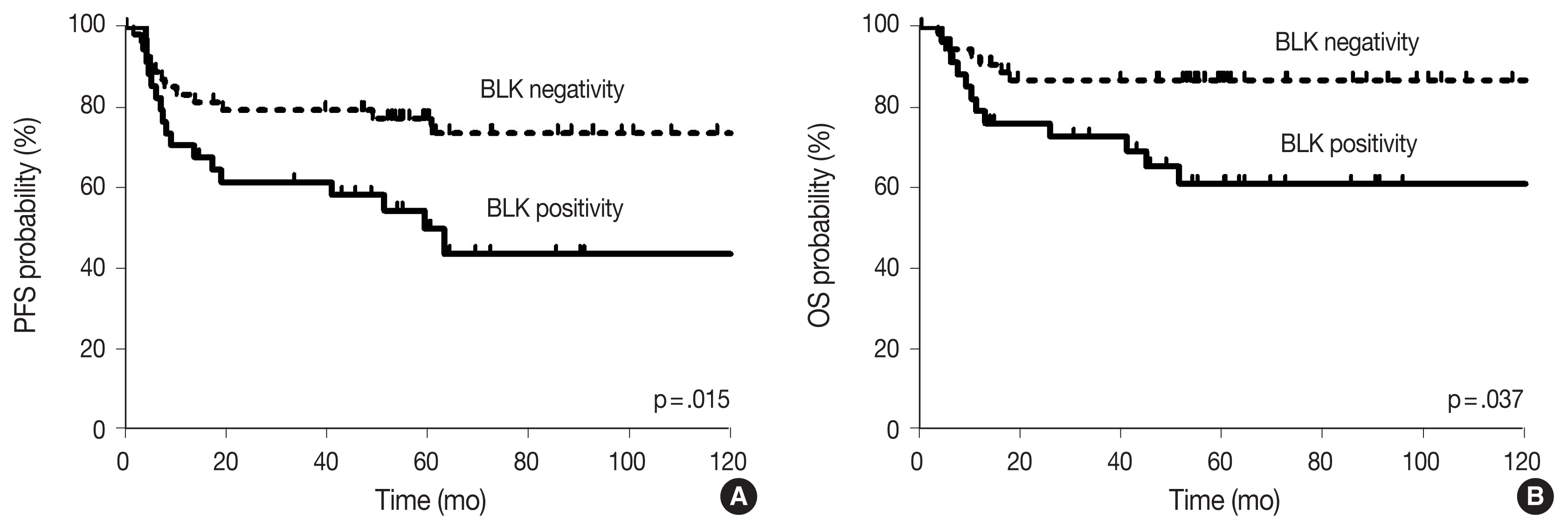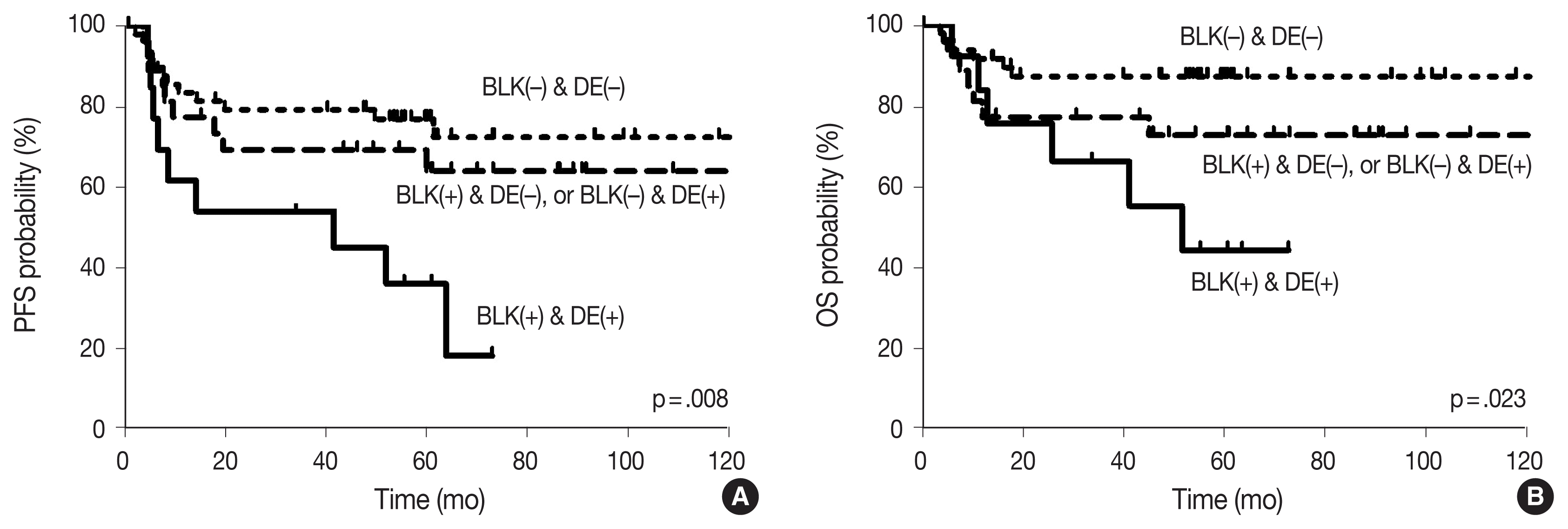1. Coiffier B, Thieblemont C, Van Den Neste E, et al. Long-term outcome of patients in the LNH-98.5 trial, the first randomized study comparing rituximab-CHOP to standard CHOP chemotherapy in DLBCL patients: a study by the Groupe d’Etudes des Lymphomes de l’Adulte. Blood. 2010; 116:2040–5.

2. Coiffier B. Rituximab in combination with CHOP improves survival in elderly patients with aggressive non-Hodgkin’s lymphoma. Semin Oncol. 2002; 29:18–22.

3. Sehn LH, Berry B, Chhanabhai M, et al. The revised International Prognostic Index (R-IPI) is a better predictor of outcome than the standard IPI for patients with diffuse large B-cell lymphoma treated with R-CHOP. Blood. 2007; 109:1857–61.

4. Staiger AM, Ziepert M, Horn H, et al. Clinical impact of the cell-of-origin classification and the MYC/ BCL2 dual expresser status in diffuse large B-cell lymphoma treated within prospective clinical trials of the German high-grade non-Hodgkin’s Lymphoma Study Group. J Clin Oncol. 2017; 35:2515–26.
5. Masir N, Akhter A, Roshan TM, et al. Diffuse large B-cell lymphoma in Southeast Asian cohort: expression patterns of B-cell receptor (BCR) repertoire and its linkage with molecular subtypes and response to R-CHOP therapy. J Clin Pathol. 2019; 72:630–5.

6. Krejsgaard T, Vetter-Kauczok CS, Woetmann A, et al. Ectopic expression of B-lymphoid kinase in cutaneous T-cell lymphoma. Blood. 2009; 113:5896–904.

7. Drebin JA, Hartzell SW, Griffin C, Campbell MJ, Niederhuber JE. Molecular cloning and chromosomal localization of the human homologue of a B-lymphocyte specific protein tyrosine kinase (blk). Oncogene. 1995; 10:477–86.
8. Zhang X, Mei D, Zhang L, Wei W. Src family protein kinase controls the fate of B cells in autoimmune diseases. Inflammation. 2021; 44:423–33.

9. Dymecki SM, Zwollo P, Zeller K, Kuhajda FP, Desiderio SV. Structure and developmental regulation of the B-lymphoid tyrosine kinase gene blk. J Biol Chem. 1992; 267:4815–23.

10. Tretter T, Ross AE, Dordai DI, Desiderio S. Mimicry of pre-B cell receptor signaling by activation of the tyrosine kinase Blk. J Exp Med. 2003; 198:1863–73.

11. Zhang M, Srivastava G, Lu L. The pre-B cell receptor and its function during B cell development. Cell Mol Immunol. 2004; 1:89–94.
12. Wang WG, Jiang XN, Liu ZB, Zhou XY, Li XQ. MYC Protein-positive diffuse large B-cell lymphoma features an activated B-cell receptor signal pathway. Am J Surg Pathol. 2017; 41:541–9.

13. Chen L, Monti S, Juszczynski P, et al. SYK-dependent tonic B-cell receptor signaling is a rational treatment target in diffuse large B-cell lymphoma. Blood. 2008; 111:2230–7.

14. Efremov DG, Turkalj S, Laurenti L. Mechanisms of B cell receptor activation and responses to B cell receptor inhibitors in B cell malignancies. Cancers (Basel). 2020; 12:1396.

15. Suh C, Kim WS, Kim JS, Park BB. Review of the clinical research conducted by the Consortium for Improving Survival of Lymphoma of the Korean Society of Hematology Lymphoma Working Party. Blood Res. 2013; 48:171–7.

16. International Non-Hodgkin’s Lymphoma Prognostic Factors Project. . A predictive model for aggressive non-Hodgkin’s lymphoma. N Engl J Med. 1993; 329:987–94.
17. Johnson NA, Slack GW, Savage KJ, et al. Concurrent expression of MYC and BCL2 in diffuse large B-cell lymphoma treated with rituximab plus cyclophosphamide, doxorubicin, vincristine, and prednisone. J Clin Oncol. 2012; 30:3452–9.

18. Bogusz AM, Kovach AE, Le LP, Feng D, Baxter RH, Sohani AR. Diffuse large B-cell lymphoma with concurrent high MYC and BCL2 expression shows evidence of active B-cell receptor signaling by quantitative immunofluorescence. PLoS One. 2017; 12:e0172364.

19. Bankhead P, Loughrey MB, Fernandez JA, et al. QuPath: Open source software for digital pathology image analysis. Sci Rep. 2017; 7:16878.

20. Mutzbauer G, Maurus K, Buszello C, et al. SYK expression in monomorphic epitheliotropic intestinal T-cell lymphoma. Mod Pathol. 2018; 31:505–16.

21. Nagato T, Ueda S, Takahara M, et al. Cyclin-dependent kinase 1 and survivin as potential therapeutic targets against nasal natural killer/T-cell lymphoma. Lab Invest. 2019; 99:612–24.

22. Chen X, Zhang FH, Chen QE, et al. The clinical significance of CDK1 expression in oral squamous cell carcinoma. Med Oral Patol Oral Cir Bucal. 2015; 20:e7–12.

23. Montero-Ruiz O, Alcantara-Ortigoza MA, Betancourt M, Juarez-Velazquez R, Gonzalez-Marquez H, Perez-Vera P. Expression of RUNX1 isoforms and its target gene BLK in childhood acute lymphoblastic leukemia. Leuk Res. 2012; 36:1105–11.

24. Petersen DL, Krejsgaard T, Berthelsen J, et al. B-lymphoid tyrosine kinase (Blk) is an oncogene and a potential target for therapy with dasatinib in cutaneous T-cell lymphoma (CTCL). Leukemia. 2014; 28:2109–12.

25. Bagnato G, Leopizzi M, Urciuoli E, Peruzzi B. Nuclear functions of the tyrosine kinase Src. Int J Mol Sci. 2020; 21:2675.

26. Zhou F, Hu J, Ma H, Harrison ML, Geahlen RL. Nucleocytoplasmic trafficking of the Syk protein tyrosine kinase. Mol Cell Biol. 2006; 26:3478–91.

27. Zeng C, Fang C, Weng H, Xu X, Wu T, Li W. B-cell lymphocyte kinase polymorphisms rs13277113, rs2736340, and rs4840568 and risk of autoimmune diseases: a meta-analysis. Medicine (Baltimore). 2017; 96:e7855.
28. Petersen DL, Berthelsen J, Willerslev-Olsen A, et al. A novel BLK-induced tumor model. Tumour Biol. 2017; 39:1010428317714196.

29. Cheng S, Coffey G, Zhang XH, et al. SYK inhibition and response prediction in diffuse large B-cell lymphoma. Blood. 2011; 118:6342–52.

30. Davis RE, Ngo VN, Lenz G, et al. Chronic active B-cell-receptor signalling in diffuse large B-cell lymphoma. Nature. 2010; 463:88–92.

31. Xu N, Lao Y, Zhang Y, Gillespie DA. Akt: a double-edged sword in cell proliferation and genome stability. J Oncol. 2012; 2012:951724.

32. Wang J, Xu-Monette ZY, Jabbar KJ, et al. AKT Hyperactivation and the potential of AKT-targeted therapy in diffuse large B-cell lymphoma. Am J Pathol. 2017; 187:1700–16.

33. Xia Y, Zhang X. The spectrum of MYC alterations in diffuse large B-cell lymphoma. Acta Haematol. 2020; 143:520–8.

34. Ondrisova L, Mraz M. Genetic and non-genetic mechanisms of resistance to BCR signaling ihibitors in B cell malignancies. Front Oncol. 2020; 10:591577.
35. Kuo HP, Ezell SA, Schweighofer KJ, et al. Combination of ibrutinib and ABT-199 in diffuse large B-cell lymphoma and follicular lymphoma. Mol Cancer Ther. 2017; 16:1246–56.

36. Wolowiec D, Deviller P, Simonin D, et al. Cdk1 is a marker of proliferation in human lymphoid cells. Int J Cancer. 1995; 61:381–8.

37. Zhao XF, Gartenhaus RB. Phospho-p70S6K and cdc2/cdk1 as therapeutic targets for diffuse large B-cell lymphoma. Expert Opin Ther Targets. 2009; 13:1085–93.

38. Zhao MY, Auerbach A, D’Costa AM, et al. Phospho-p70S6K/p85S6K and cdc2/cdk1 are novel targets for diffuse large B-cell lymphoma combination therapy. Clin Cancer Res. 2009; 15:1708–20.

39. Bernasconi M, Ueda S, Krukowski P, et al. Early gene expression changes by Epstein-Barr virus infection of B-cells indicate CDKs and survivin as therapeutic targets for post-transplant lymphoproliferative diseases. Int J Cancer. 2013; 133:2341–50.








 PDF
PDF Citation
Citation Print
Print



 XML Download
XML Download